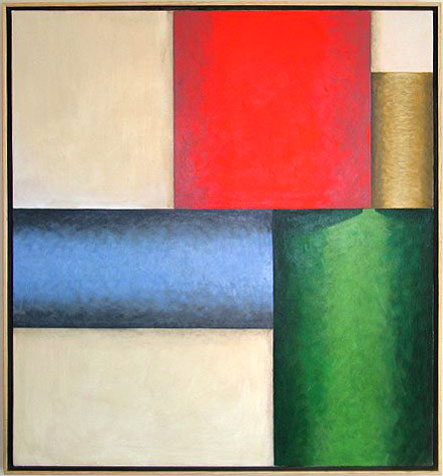Abstract Painting can be said to have started
with Wasily Kandinsky who was among the first to consider the idea
of the painting itself being its own subject. A lot of the original
idea was to create a visual art that was the creative equivalent
of music. With theosophy and esotericism in general being in vogue
at the time, efforts were being made to create interrelationships
between the disciplines of the various senses so that there efforts
made to make musical equivalents of visual art and visual equivalents
of musical sensations.
Additionally there was a strong impulse to move away from the
representation of physical sense objects and toward a more inwardly
and intuitive direction of one's artistic efforts. In his Concerning
the Spiritual in Art, Kandinsky attempted to offer meanings
to basic shapes, forms, and colors. Another Russian, Kasamir Malevich.
who is the father of Suprematism, an early abstract art movement
which created the term Non-Objective Art which referred to art
that had no references to the world of physical nature. The Dutch
artists Piet Mondrian and Theo van Doesburg started the movements
called Neo Plasticism (The New Plastic Art) and De Stijl (The Style)
in the 1920's. Mondrian wrote extensively on the topic and Van
Doesburg, an architect, was instrumental in what would become Modernist
architecture and the design of everyday objects like fabrics, chairs,
light fixtures, etc. all of which is based in the clean pared down
aesthetics of abstraction and non-objective art developed at
that time.
This led to the formation of the Bauhaus and at the same time
in Russia Constructivism was developing which is the basic term
for much of the art and architecture since that time. During the
Dada period Hans Arp was creating an organic style of abstract
art and Miro was developing his own form of Abstraction though
inventing a language of forms which he used recurrently throughout
his career. Kurt Schwitters made his most influential contribution
in the area of collage, all of which tended toward abstract relationships.
Other early movements that had strong abstract elements include
synthetic Cubism, Orphism, Futurism, Purism, etc.
Between the world wars there was a great deal of experimentation
between the two poles of organic and geometric styles of abstraction.
After world war two, due to the position of dominance and good
will held by the United States, the style called Abstract Expressionism
and the New York School came to the foreground. In the 60's Abstract
art was in full bloom all over the world and was expressed in a
number of different art movements such as Op Art, Minimalism, etc.
At this point Abstract and Non-objective art is widely practiced
by a large number of artists from all over the world.
This only covers things with a very broad brush and in no way
scratches the surface on the great diversity and profundity of
the fascinating work that has been done in the field of abstract
art to date but this should give enough of a back ground to begin
to see where Mr. Touchon's work fits into the picture. Over the
years Touchon has touched on just about every noteworthy theme
and painter within the pantheon of abstract art to date.
Web Site: http://touchon.com/ |
